How To Calculate Dilutions
What do you want after a long, hot day in the sun: pure lemon juice or lemonade? Pure lemon juice probably won't hit the spot. Lemonade, on the other hand, would be perfect.
This is because while lemonade does contain some of the flavor of lemon juice, it has been diluted with water and enhanced with sugar to make it exactly what you need. In the same way that drinking pure, concentrated lemon juice isn't very appealing, scientists often don't need pure, concentrated chemicals to do the work they want to do.
How Does Dilution Work?
How Does Dilution Work?
At its core, dilution simply means making an initial solution less strong. For example, adding water to pure lemon juice so that you retain the lemon flavor and the mouth-puckering pure lemon juice isn't quite as strong, is a dilution.
Diluting a Stock Solution to a Desired Working Concentration
Diluting a Stock Solution to a Desired Working Concentration
A working solution is a less concentrated solution that you want to work with. A stock solution is the concentrated solution you begin with. So how do you get a working solution? Well, you add diluent or solvent to the stock solution in order to obtain a working solution.
Say you have a 6 M stock solution of hydrochloric acid (HCl), and you need 100 mL of 0.5 M HCl to work with in the lab. You will need to take some amount of the stock solution and add diluent to it (water, in this case) in order to achieve a less concentrated solution. Before going on, let's give these different values names so that keeping track of them is easier.
1\. The stock solution that you have will be called M1 or molarity one. The subscript number one refers to the fact that this is the initial concentration.
2\. The working solution concentration that you want will be called M2 or molarity 2. The subscript number two refers to the fact that this is the second solution you make.
3\. The working solution volume that you want will be called V2 or volume 2. This volume is how much solution you want to make to work with in lab.
Now that you have these terms defined, there is actually an equation you can use to calculate the volume of stock solution you will need to use (V1).
This equation is called the dilution equation:
\(M_1V_1 = M_2V_2\)
For this example:
\(\M_1 = 5M\enspace stock\enspace solution\enspace HCl
\V_1 = ?\enspace mL
\M_2 = 0.5M\enspace working\enspace solution\enspace HCl
\V_2 = 100 mL\)
Substituting the variables gives you:
\(6M\enspace HCl*V_1 = 0.5M\enspace HCl*100\enspace mL\)
You can now solve for V1:
\(V_1 = 10mL\enspace stock\enspace solution\enspace HCl\)
This means that in order to make 100 mL of 0.5M HCl solution you would take 90 mL of water and add 10 mL of 5M HCl.
How Do You Make a 10% Solution?
How Do You Make a 10% Solution?
Solutions by percentage can refer to one of three things, so a 10% solution may refer to any of the following:
% w/w = % weight/weight
% w/w is read as "percent weight by weight" and means that the composition of the solution is characterized by the weight of a certain substance as compared to the weight of the diluent. For example, a 10% w/w solution of acetic acid means 100 grams of solution contains 10 g of acetic acid and 90 g of water.
% w/v = % weight/volume
%w/v is read as "percent weight by volume" and means that the composition of the solution is characterized by the weight of a certain substance as compared to volume of the diluent. It should be used when talking about dissolving a solid chemical into a liquid diluent. For example a 10% w/v solution of NaCl means 10 grams of NaCl were added to a solution whose final volume was brought up to 100 mL.
% v/v = % volume/volume
%w/v is read as "percent volume by volume" and means that the composition of the solution is characterized by the weight of a certain substance as compared to the volume of the diluent. It should be used when talking about dissolving a liquid chemical into a liquid diluent. For example a 10% v/v solution of HCl means 10 mL of HCl were added to 90 mL of water to obtain a solution whose final volume is 100 mL.
Diluting Stock Solutions by Percentage
Diluting Stock Solutions by Percentage
The dilution equation works even when you don't have a molarity associated with the stock. Let's say someone gives you a 10% stock solution of sodium azide, and you need to make 500 mL of a 0.1% working solution. You can use the same equation to do so as shown here:
\(\M_1 = 10\%\enspace stock\enspace solution
\V_1 = ?\enspace mL
\M_2 = 0.1\%\enspace working\enspace solution
\V_2 = 500 mL\)
\(\M_1V_1 = M_2V_2
\10\%*V_1 = 0.1\%*500 \enspace mL
\V_1 = 5mL \enspace10\% \enspace stock \enspace solution\)
This means you will need 5 mL of the 10% stock solution and 495 mL of diluent.
As long as you have three pieces of information to plug into the dilution equation you will be able to solve for the last unknown. Now you have a quick way to calculate dilutions when you have a stock solution.
Cite This Article
MLA
Gupta, Riti. "How To Calculate Dilutions" sciencing.com, https://www.sciencing.com/calculate-dilutions-5990363/. 1 February 2020.
APA
Gupta, Riti. (2020, February 1). How To Calculate Dilutions. sciencing.com. Retrieved from https://www.sciencing.com/calculate-dilutions-5990363/
Chicago
Gupta, Riti. How To Calculate Dilutions last modified March 24, 2022. https://www.sciencing.com/calculate-dilutions-5990363/
